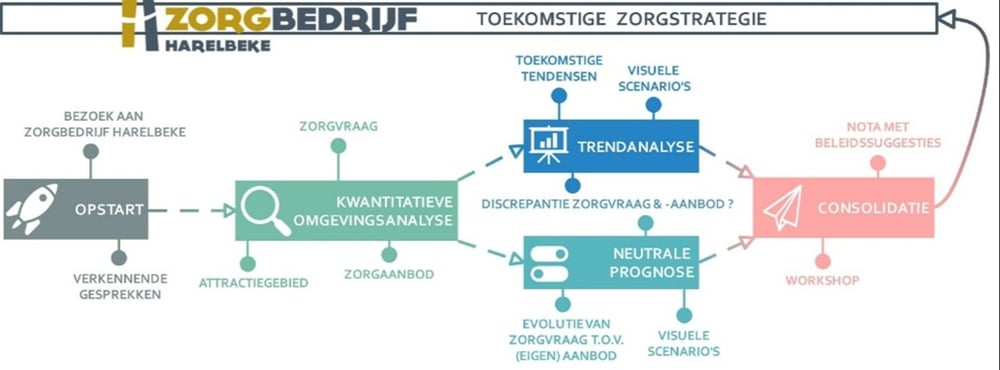Strategic challenge
wants to flesh out a future care strategy. When making strategic choices, the organisation wants to base itself on a study that examines, discusses and draws conclusions from relevant quantitative and qualitative aspects of care demand, care supply and possible trend developments. In this context, Möbius was appointed to conduct this in-depth study by conducting a comprehensive environmental analysis, a neutral and trend forecast as well as formulating policy suggestions.
Approach
The action plan consisted of five sub-phases, as illustrated in the figure. The project started with a brief desk research of relevant documents about Zorgbedrijf Harelbeke and some exploratory interviews with key people to get to know the organisation and its service offer well.

A comprehensive an accurate environment analysis was then developed; it was periodically explained to the Project Group, which thus had the opportunity to ask additional questions. Through this iterative process, the Project Group had a thorough understanding of the analysis, key factors and trends. For this environment analysis, the attraction area (at the level of local administrations and frontline zones) of Zorgbedrijf Harelbeke was first determined in order to then identify (the factors related to) the demand for care and the supply of care. To this end, maximum use was made of existing data sources and data. The results were also checked against the expertise and insights within Zorgbedrijf Harelbeke.
In a third and fourth phase, several forecasts were made to determine how demand for care will evolve with regard to the care on offer in the catchment area and with regard to the organisation's own care on offer. This was always based on the quantitative data from the environmental analysis. The neutral prognosis looked at the evolution in demand and supply of care under an unchanged policy. The trend-based prognosis took into account possible future trends and their impact on demand and supply of care. We consider changes in preferences of the elderly (e.g. staying at home as long as possible), but also technological innovations, innovative housing forms and policy initiatives. Indeed, inspiring sources and ideas from practice both at home and abroad were identified on the basis of a thorough literature review. Finally, the future discrepancy in care supply and demand was also described throughout.
Results
The results of the environmental analysis and forecasts were comprehensively consolidated in a note. Based on these conclusions, some policy recommendations were then formulated in function of Zorgbedrijf Harelbeke's future care strategy. These suggestions form the basis for defining the strategic compass pointers for the organisation and are further used by Zorgbedrijf Harelbeke as a working tool to work with concretely in defining the future care strategy.






